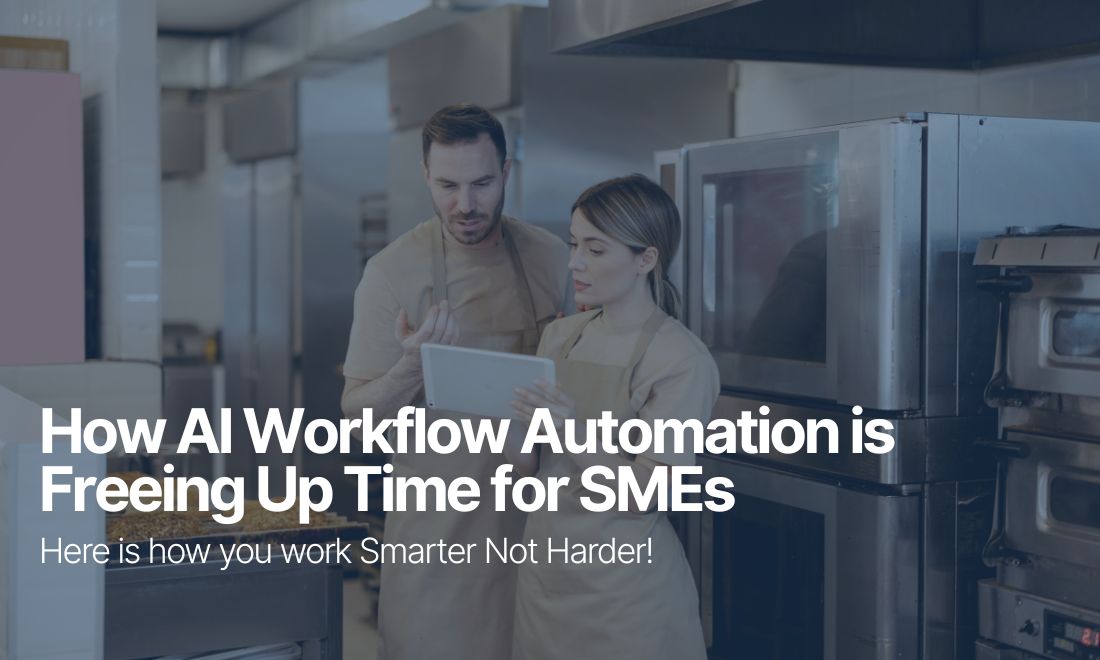Smarter Not Harder: How AI Workflow Automation is Freeing Up Time for SMEs
At 7:30am in Liverpool, Sarah’s already scrolling through delivery updates while juggling supplier invoices. She runs a small distribution company with six staff, one rented warehouse, and a mountain of admin. By lunchtime, she’s re-entered the same figures twice and hasn’t touched the day’s real priorities.
She’s not alone.
Across the UK, small and medium-sized businesses are losing time, focus, and margin to repetitive admin. But it doesn’t have to be this way. With the right tools, AI automation quietly takes the grunt work off your plate — and gives you your mornings back.
AI Isn’t Just for Tech Giants Anymore
AI used to sound like something only Google or Amazon could afford. But today’s tools are designed for people like Sarah. For bike shops in Bristol. Bakeries in York. Anyone doing too much with too little time.
Modern workflow automation tools are lean, affordable, and focused on solving real problems all without the fluff, and without replacing the human touch.
At Think Menai, we help SMEs bridge the gap between opportunity and implementation. This is what that looks like.
What Is Workflow Automation, Really?
Let’s strip the jargon.
Workflow automation means linking the tools you already use like Gmail, Xero, Google Sheets, or your CRM so repetitive tasks get done without you lifting a finger. Think:
- Emails sent automatically when a form is filled
- Invoices filed the moment they land
- Customers updated as soon as their order ships
- Stock levels flagged before you run out
It’s not about removing people. It’s about removing friction.
Real Examples: Where AI Is Already Earning Its Keep
1. Invoices That File Themselves
Remember Sarah? Instead of typing numbers late into the evening, she now uses Xero. The platform scans invoices, matches them to suppliers, and files them for her. What used to take hours? Done in minutes.
2. Customer Queries That Answer Themselves
A bike shop owner in Bristol was drowning in questions like “Are you open Sunday?” and “Do you have this part?” Now, an AI chatbot on his site handles the FAQs and flags the detailed ones to staff. Customers get instant answers, and he gets his inbox back.
3. Scheduling Without the Ping-Pong
An electrical contractor in Snowdonia used to spend hours booking client calls. Now they use Calendly. The tool connects to their diary, offers real-time availability, and sends reminders. Zero back-and-forth.
4. Stock That Thinks Ahead
A York bakery uses AI to analyse daily sales. The system noticed sausage rolls always ran out by 3pm on Fridays. Now the owner gets a Thursday prompt to bake more. Fewer disappointed customers, less waste, more profit.
But Isn’t This Stuff Complicated?
Honestly? No.
Most SME-friendly AI tools are plug-and-play. Dashboards are simple. Costs are low. You don’t need a dev team — just a clear goal and the right starting point.
Here’s what people worry about:
- “It’s too expensive” → Most tools are under £50/month
- “It’ll replace my team” → It replaces tedium, not people
- “It’s too technical” → If you can send an email, you can use Zapier
And if you want a helping hand, that’s what we’re here for.
Quick Start Checklist: 10 Minutes to Spot Opportunity
- List 3 tasks you repeat every week
- Ask: Could a tool trigger this? File it? Notify someone?
- Explore tools like Zapier, Xero, Tally, Calendly, Freshdesk
- Test one process first – small, trackable, low-risk
- Review after 30 days – is it saving time? Improving flow?
Let’s Make the Boring Stuff Disappear
AI isn’t about showing off. It’s about getting your time back. Your focus. Your clarity. And maybe even your Friday afternoons.
Whether you’re just curious or ready to build, we’ll help you spot the wins and start small. Because that’s how smart automation scales — quietly, effectively, and with purpose.
Give us a call on 01286 875872 or email hello@thinkmenai.com. The first step is a 10-minute conversation and it might just save you 10 hours this week.

